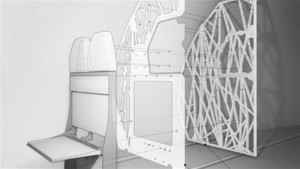Airbus creates 3D Printed Partition that is set to transform the Aviation industry
Swift, agile, resilient- these are the characteristics that are often associated with airplanes. As a progressive and innovative industry, the field of Aerospace is constantly evolving. Therefore, it is no surprise that 3D Printing Technology has been incorporated into various aspects of the industry such as prototyping, tooling, replacement of obsolete parts and even end use parts.
For instance, last May, it was announced that Stratasys had collaborated with Airbus to produce over 1,000 flight ready parts. Through 3D Printing Technology, Airbus was able to obtain the necessary parts quickly and efficiently, hence enabling them to meet the delivery deadlines easily. The use of the material, ULTEM™ 9085 resin also allowed for the production of strong, lightweight parts and facilitated the creation of a more optimized and streamlined design, thus leading to material and cost savings.
However, Airbus did not stop there. Just last month, they unveiled their plans for a new project, namely, the designing and creation of a 3D Printed partition. Claimed to be 45% lighter than its conventional counterpart, the 3D Printed partition is set to transform the Aviation industry, not only in terms of reduced costs but environmental benefits as well. Through the use of the alloy known as ‘Scalmalloy’, Airbus is able to achieve the desired amount of durability while keeping the weight to the minimum.
In addition, Airbus AP Works also ensured that the lightest and most ideal design was attained through their research of natural structures such as the bone structure of a fish’s jaws or composition of water lilies. From there, they were then able to develop a 3D Printed partition that was tensile and could withstand pressure, both of which were crucial elements needed to support the weight of the jump seats used by the cabin crew. The reduced weight of the 3D Printed partition would then result in a decreased amount of fuel required and subsequently reduce airline operating expenses. Taking into consideration that fuel forms up to 2/5 of the operational costs (Clark, 2014. The New York Times), this would mean greater profit margins for airlines along with lower airfare prices for consumers, making it a win-win situation. Most importantly, if Airbus were to implement this new 3D Printed Partition into their airplanes, they would be able to cut down on a significant amount of Carbon Dioxide emission, namely up to 465,000 metric tons of it, thus making it more environmentally friendly.
Although there is currently a slower yet steadily growing adoption rate of 3D Printing Technology for end use parts and products in the Aviation industry now as compared to prototypes or tooling, we believe that this will change in the near future. With advancements in 3D Printing Technology and complementing 3D software, more optimal and customized designs can be developed and materialized. Intricate and organic shapes can be created according to the part’s specific requirements, thus allowing for lesser material consumption and enhanced performance. Furthermore, in-fills can also be tailored to suit the manufacturer’s specifications, with honeycomb and sparse in-fills available for parts and structures that do not require so much density. This in turn then reduces the overall weight of the part and contributes to the overall aerodynamic effectiveness and efficiency.
Lesser design revisions would also be needed, which would mean that designers and engineers would have more time to experiment with various possibilities but still maintain quality. Small parts can also be consolidated to form larger components and hereby resulting in lesser assembly time and a quicker product development cycle.
Overall, the advantages that can be reaped from the integration of 3D Printing Technology into the design and manufacturing process in the Aerospace industry is aplenty and it is essential that industry players capitalize on this so as to maintain their relevance and competitive edge.
For more information about the different applications of 3D Printing Technology in the Aerospace Industry, please feel free to check out the various case studies here. Alternatively, if you are interested in knowing more about the types of 3D Printing materials that are commonly used in the Aerospace industry, please proceed here and here respectively.
Aside from that, you can also check out the full article on the entire creation process of the 3D Printed Partition by Airbus AP Works and The Living here.
*Pictures credit to and taken from 3ders.com


